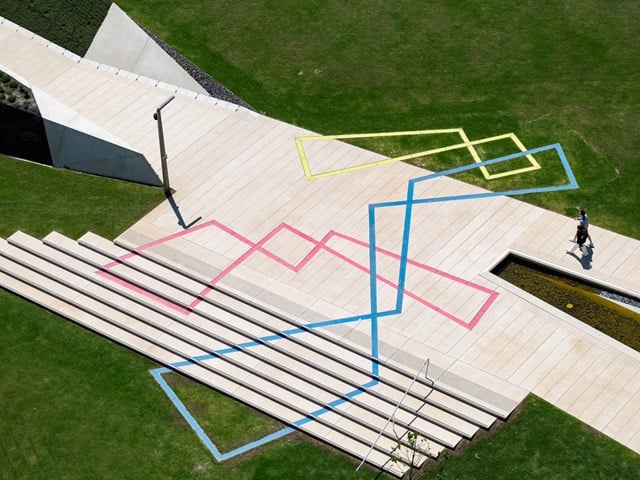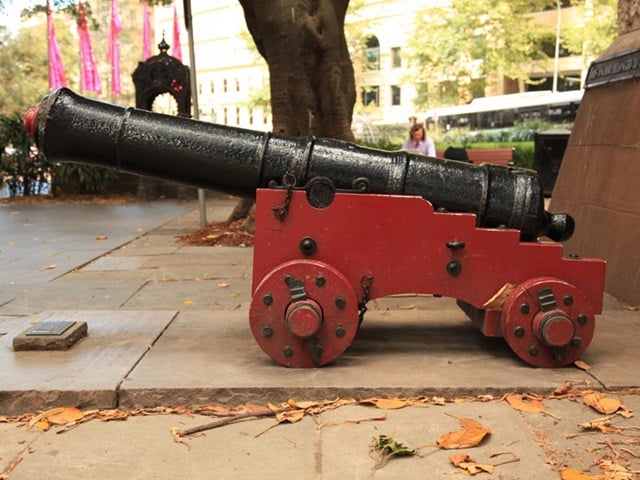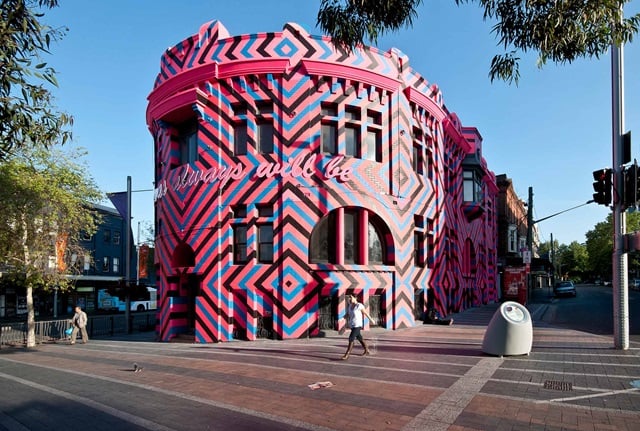


A contemporary ‘folly’ referring to the time and rule of Governor Macquarie and his wife.
Curator: Sally Couacaud
Artwork description
Folly for Mrs Macquarie by Fiona Hall is a contemporary ‘folly’ drawing on historical, geographic and cultural aspects of the time and rule of Governor Macquarie and his wife, Elizabeth.
Commissioned as part of the Sydney Sculpture Walk for the Sydney 2000 Olympics, the artwork is in front of the grounds of Government House looking over to Mrs Macquaries Point and through to the heads of the harbour. The artwork implies an element of folly in the optimistic act of superimposing old world traditions onto foreign surroundings.The design elements echo those early aspirations but also remind us that there was much folly in the way Britain colonised Australia. The domed roof of Norfolk Island pine fronds, for example, refers to the colonists’ regard for the tree. But the brittle timber of the pines dashed hopes it would make excellent masts for ships.
Formal elements are expressed in the Neo-Classical Gothic style favoured by the Macquaries and include a range of references – indigenous and introduced plant species, early colonial tools, the clasped dagger from Macquarie’s crest and fencing. The false ceiling represents interlocking animal bones of native species which would once have inhabited the site, while the structure of the Gothic windows represents the barbed wire that divided up the unceded land. Sunken seating provides a place to pause, sit and contemplate the views over the harbour.
Artist
Fiona Hall is a prominent artist based in Adelaide, South Australia. She works in photography, sculpture, painting, installation, garden design and video. Hall’s choice of material, and the way she uses it, is critical to her art. She deliberately transforms ordinary everyday objects to address a range of contemporary issues such as globalisation, consumerism, colonialism and natural history. The core theme throughout Hall’s work is the relationship between nature and culture.
Inscription
The Sydney Sculpture Walk plaque at the site read:
Fiona Hall
Lachlan Macquarie and his wife governed in Sydney from 1810 to 1821. They arrived with a pattern book for buildings in the Neo-Classical style and a desire to transform the colony. This part of the harbour foreshore was landscaped in the Picturesque manner fashionable in Britain at that time. A sketch from the period indicates that Mrs Macquarie had a folly constructed.
The design elements of the folly echo those early aspirations for the colony, but are also mindful that there was much folly in the way in which Britain chose to colonise Australia. The domed roof of Norfolk Island pine fronds for example refers to the colonists’ regard for this tree (Mrs Macquarie presided over the planting of one near here in 1816 which became known as the wishing tree). However the pine’s brittle timber dashed hopes that it would make excellent ship masts. The bone ceiling refers to animals which once lived in this area, and the Gothic Windows represent the barbed wire used to claim and divide up the land. The finial is from the Macquarie family crest while the folly floor indicates the direction of Britain from this site.
Installed: October 2000







